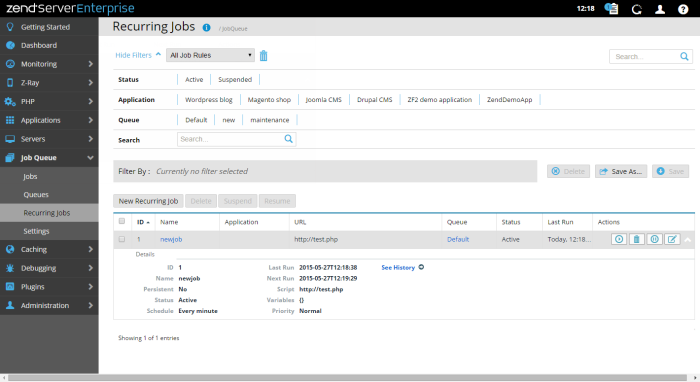The Recurring Jobs page is the central area for configuring jobs to run by URL. Running jobs by URL makes it easy to eliminate situations where the same file is run in multiple instances, such as off-loading tasks from the synchronous user request to an external, parallel PHP process.
How do I create a new recurring job?
Note:
Zend Server
also provides the ability to Schedule Jobs using the Job
Queue![]() A simple and manageable system for off-loading tasks from the synchronous user request, to an external, parallel PHP process. API Zend Job Queue API . To read more about how to work with jobs, see Working with Jobs.
A simple and manageable system for off-loading tasks from the synchronous user request, to an external, parallel PHP process. API Zend Job Queue API . To read more about how to work with jobs, see Working with Jobs.
The Filters area is used to select and create filters for displayed jobs in the Jobs list:
- Action Bar- Contains all filter related action items, and displayed by clicking Show Filters:
Name
Button
Description
Filter-Set Menu

Click to display list of default and saved filter-sets.
Clear Filters

Click to clear selected filters
Delete

Deletes a filter.
Save As

Saves a filter after customization as a new filter.
Save

Saves a new filter.
Search

Searches job rules list for entered search pattern.
- Filter list - Displays all available categories and filters:
Status - Filters jobs by status ( e.g., suspended).
Application - Filters jobs by the application they are associated with.
- Search - Filters jobs by entered search pattern.
- Filter By - Displays all selected filters.
The action bar is located at the top of the page, and is used to manage your recurring jobs:
|
Name |
Button |
Description |
|
New Recurring Job |
|
Creates a new recurring job. Displays the New/Edit Recurring Jobs page. |
|
Delete |
|
A multi-selection for deleting redundant or unused jobs |
|
Suspend |
|
Temporarily stop the job from running while still saving the job definitions. |
|
Resume |
|
Un-suspend a job. |
Job rules are displayed in a list. The information for each listed job is sorted into columns:
- ID - ID number of the job.
- Status - An indicator of the job's state: Pending, Waiting for predecessor, Running, Completed, Ok, Failed, Logically failed, Timeout, Scheduled, Suspended.
- Name - The name of the job.
- Application - The name of the application associated with the job.
- URL - The location of the job file to be run.
- Queue - The name of the queue the job is assigned to.
- Last Run - The date and time the job last ran.
- Actions - Job action items (appear when applicable):
Name
Icon
Description
Run

Run the job.
Delete

A multi-selection for deleting redundant or unused jobs.
Suspend

Temporarily stop the job from running while still saving the job definitions.
Resume

Un-suspend a job.
Edit

Open the job for editing to modify settings.
Selecting a job from the list, or clicking the Expand View arrow  on the right, displays an expanded view of the job.
on the right, displays an expanded view of the job.
The expanded view includes:
- Details tab:
- ID - ID number of the job.
- Name - The name of the job.
- Persistent - Indicates whether the job is subject for issue sweeping by daemon (Yes, No).
- Status - An indicator of the job's state: Pending, Waiting for predecessor, Running, Completed, Ok, Failed, Logically failed, Timeout, Scheduled, Suspended.
- Schedule - The date and time intervals the job is set to run on.
- Last Run - The date and time the job last ran.
- Next Run - The date and time the job will next run.
- Script - The URL of the script to be executed (e.g., http://my.operations.server/job.php).
- Variables - The input variables that the job received.
- Priority - The Job's priority. Recurring Jobs are always set to normal. Jobs created with the Job Queue API can hold different priorities. In addition to normal they can be Low, High or Urgent depending on the importance of the job.
- See History - Link to Jobs page to view the job history.






